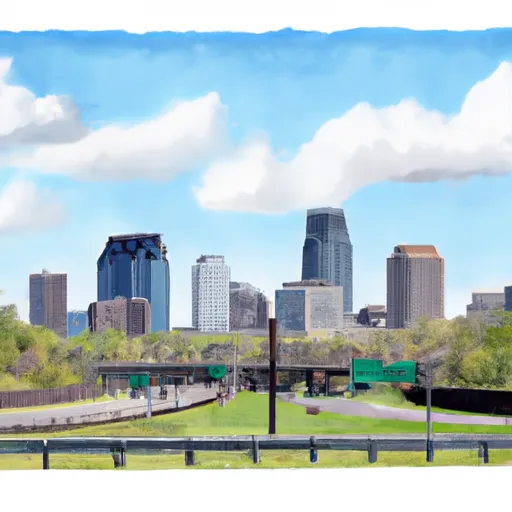-
 Snoflo Premium
Snoflo Premium
Get unlimited access to all our content
With no Ad interruptions! - Start Your Free Trial Login with existing account
Young-America
Eden Index
Climate
6.4
•
Recreation
2.5
•
Community
3.7
•
Safeguard
4.4/10

Young-America is a small city located in Carver County, Minnesota, with a population of around 1,000 residents. The climate in Young-America is characterized by cold winters and mild summers. The average high temperature in January is around 23°F (-5°C), and in July, it reaches about 82°F (28°C). The city experiences moderate rainfall throughout the year.
Hydrologically, Young-America is situated near various bodies of water, including lakes and rivers. The nearby Carver Lake and Lake Waconia offer excellent opportunities for fishing, boating, and other water-based activities. The city is also close to the Minnesota River, providing additional options for outdoor enthusiasts.
In terms of outdoor recreation, Young-America offers several opportunities. The area is surrounded by picturesque landscapes and is ideal for hiking, biking, and nature walks. Nearby parks such as Baylor Regional Park and Lake Minnetonka Regional Park offer beautiful trails, picnic areas, and opportunities for wildlife viewing. During the winter, residents and visitors can enjoy ice fishing, snowshoeing, and cross-country skiing in the surrounding areas.
Overall, Young-America's climate, proximity to water bodies, and diverse outdoor recreation opportunities make it an attractive destination for nature lovers and outdoor enthusiasts.
What is the Eden Index?
The Snoflo Eden Index serves as a comprehensive rating system for regions, evaluating their desirability through a holistic assessment of climate health, outdoor recreation opportunities, and natural disaster risk, acknowledging the profound impact of these factors on livability and well-being.
Climate Health Indicator (CHI): 6.4
Young-America receives approximately
780mm of rain per year,
with humidity levels near 81%
and air temperatures averaging around
7°C.
Young-America has a plant hardyness factor of
4, meaning
plants and agriculture in this region thrive during a short period during spring and early summer. Most
plants will die off during the colder winter months.
By considering the ideal temperature range, reliable water supplies, clean air, and stable seasonal rain or snowpacks, the Climate Health Indicator (CHI) underscores the significance of a healthy climate as the foundation for quality living.
A healthy climate is paramount for ensuring a high quality of life and livability in a region, fostering both physical well-being and environmental harmony. This can be characterized by ideal temperatures, reliable access to water supplies, clean air, and consistent seasonal rain or snowpacks.
Weather Forecast
Streamflow Conditions
Upper Mississippi-Crow-Rum
Area Rivers
Upper Mississippi-Crow-Rum
Snowpack Depths
Upper Mississippi-Crow-Rum
Reservoir Storage Capacity
Upper Mississippi-Crow-Rum
Groundwater Levels
Recreational Opportunity Index (ROI): 2.5
The Recreational Opportunity Index (ROI) recognizes the value of outdoor recreational options, such as parks, hiking trails, camping sites, and fishing spots, while acknowledging that climate plays a pivotal role in ensuring the comfort and consistency of these experiences.
Access to outdoor recreational opportunities, encompassing activities such as parks, hiking, camping, and fishing, is crucial for overall well-being, and the climate plays a pivotal role in enabling and enhancing these experiences, ensuring that individuals can engage in nature-based activities comfortably and consistently.
Camping Areas
| Campground | Campsites | Reservations | Toilets | Showers | Elevation |
|---|---|---|---|---|---|
| Winnie Dam | None | 1,334 ft | |||
| Williams Narrows | 17 | 1,328 ft | |||
| Ronald Cloutier - Cross Lake | 120 | 1,246 ft | |||
| West Seelye Bay | 22 | 1,418 ft | |||
| Washburn Lake - Land OLakes State Forest | 30 | 1,347 ft | |||
| Onegume | 46 | 1,338 ft | |||
| East Seelye Bay | 13 | 1,342 ft | |||
| Aitkin County Campground | 7 | 1,201 ft | |||
| Plug Hat Point | None | 1,368 ft | |||
| Deer Lake | 48 | 1,413 ft |
Nearby Ski Areas
Catastrophe Safeguard Index (CSI):
The Catastrophe Safeguard Index (CSI) recognizes that natural disaster risk, encompassing floods, fires, hurricanes, and tornadoes, can drastically affect safety and the overall appeal of an area.
The level of natural disaster risk in a region significantly affects safety and the overall livability, with climate change amplifying these risks by potentially increasing the frequency and intensity of events like floods, fires, hurricanes, and tornadoes, thereby posing substantial challenges to community resilience and well-being.
Community Resilience Indicator (CRI): 3.7
The Community Resilience Indicator (CRI) recognizes that education, healthcare, and socioeconomics are crucial to the well-being of a region. The CRI acknowledges the profound impact of these elements on residents' overall quality of life. By evaluating educational resources, healthcare accessibility, and economic inclusivity, the index captures the essential aspects that contribute to a thriving community, fostering resident satisfaction, equity, and social cohesion.

